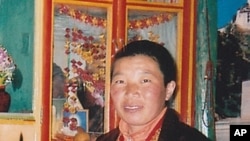China says a Tibetan nun has died after setting herself on fire in southwestern China. It was the 11th such self-immolation protest this year involving Buddhist monks and nuns in the restive region.
Palden Chetso, 35, died Thursday in Sichuan province. A witness told VOA's Tibetan service he found the nun drenched in gasoline on a local roadway moments before she set herself ablaze. She said she was prepared to sacrifice for greater freedoms and the return of the exiled Tibetan spiritual leader, the Dalai Lama.
Eight Buddhist monks and two nuns have self-immolated since a young protesting monk died after setting himself on fire in March at the flashpoint Kirti monastery. That death sparked months of protests by monks and nuns and triggered a major Chinese crackdown on area monasteries that included the arrests and disappearances of hundreds of monks.
In Washington Wednesday, the head of the Tibetan government in exile, Lobsang Sangay, urged the United States to press China for access to the region to investigate the incidents and the crackdown.
He also denied Chinese accusations that his exile government has encouraged the self-immolations.
"So, as a matter of principle, Tibetan administration based in India, which I am the head, do not, do not encourage protests inside Tibet, or for that matter, self-immolation as well, because, mainly because we know the consequences. If you protest in Tibet, more often than not you get arrested, or beaten up, sometimes tortured; sometimes you disappear, sometimes you die," he said.
Sangay said the immolations demonstrate the failure of Chinese policies in Tibet, where the Beijing government has spent billions of dollars on infrastructure projects in a bid to win over a sometimes restive population.
"After 60 years, the socialist paradise generation, in the sense those Tibetans who grew up under the Chinese system of education, of propaganda, of economy, of culture are saying: 'Enough. This is unbearable. We can't live under the circumstances.' And they are resorting to a tragic method, a desperate method of self-immolation. So, clearly the Chinese government['s] hard-line policies are not working."
He also affirmed that the protesting monks and nuns were acting to demand greater freedom of religion and the return to China of the Dalai Lama, who lives in exile in northern India.
"One thing is very clear. As they were, as they set themselves on fire, as they were on fire, almost all of them cries or says two main slogans. One is 'Freedom for Tibetans' or 'Freedom in Tibet.' And, two, 'Long live His Holiness the Dalai Lama' or 'Return of His Holiness Dalai Lama to Tibet.' So, one can only imagine how it feels to be yourself in fire."
Sangay has taken over the political leadership of the Tibetan exile movement from the Dalai Lama, who announced this year that he will restrict himself to his role as a spiritual leader. China denounces the Dalai Lama as a "splittist" who seeks independence for Tibet, though the Dalai Lama denies it.
Some information for this report was provided by AP, AFP and Reuters.












